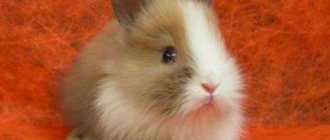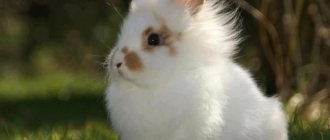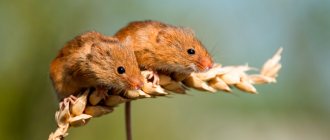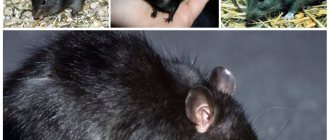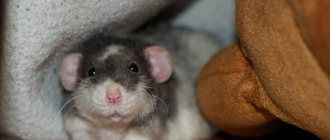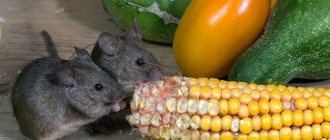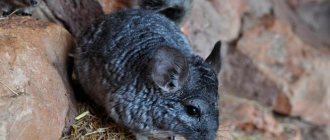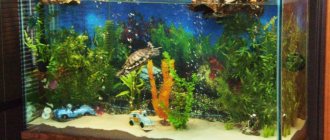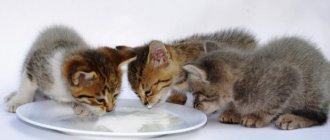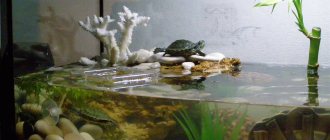Mice in history and culture
In ancient Greece, the white mouse was considered a sacred animal.
Colonies of thousands of animals lived in the temples. They were heroes of legends and myths. They thought that the white mouse helped the oracles see the future, and the active reproduction of animals promised prosperity and a good harvest. The black mouse was considered a product of dirt and was subject to extermination. In Japan they believed that a white mouse brings happiness. Seeing a place where a colony of rodents lives is a good sign, but a dead mouse meant grief. The Chinese considered this animal a symbol of wisdom and honesty. But among the ancient Persians and Egyptians, on the contrary, both the white and black mice were endowed with destructive, evil powers. They associated rodent invasions with the machinations of the terrible god Ahriman.
Cats appeared in the human home due to the dominance of harmful rodents. Even 6 thousand years ago, people began to feed wild cats, and they, in turn, began to protect their food supplies. But even now mice remain a favorite pastime for domestic cats. This long-standing enmity is the basis of many fairy tales, songs, cartoons, and proverbs. In the Internet era, special videos for cats have appeared. A mouse on the screen becomes a reason for a domestic cat to remember its hunting instincts.
Interesting facts about mice
- Mice don't like cheese at all. Rather, animals will prefer whole grains or seeds. The favorite treat for these little rodents is smoked lard. It is often used as bait in a mousetrap.
- Just one year is how long a male marsupial mouse lives. Nature gave these animals only 2 weeks to reproduce. After mating, which lasts 10-13 hours, the male dies to give life to his babies.
- Smell is of great importance in communication between mice. With the help of “odorous” marks (from feces, urine, secretions from glands), rodents delimit territory, orient themselves in space, and transmit information to each other. Each mouse family has its own unique smell, which indicates the genetic affiliation of the animal.
- The cheerful, bug-eyed mouse, the restless little one, is the constant heroine of the modern multimedia world. Fun tablet and phone games offer to catch the mouse on the screen; For a domestic cat, this can become a real drug, and for its owner - a reason to laugh heartily.
Mice are the smallest rodents on the planet, bringing both benefit and harm to people. They spoil crop supplies and are carriers of dangerous infections. But using mice in scientific research helps save human lives.
Diverse in appearance and lifestyle, mice are often easy prey for predatory reptiles, birds and mammals. Because of this, animals rarely live long lives. Their small size, calm temperament and funny behavior make these rodents suitable for keeping as pets. Animals that are lucky enough to become people's favorites live much longer than their wild relatives.
What determines the lifespan of a rodent?
A free lifestyle for rodents has more disadvantages than advantages. Newborn rat pups can be eaten by their relatives; birds of prey, cats and dogs are ready to drag away growing babies. The life of an adult animal is also full of dangers: people are not happy with such neighbors, garbage dumps are not filled with healthy food, the weather is not always ideal. Wild rats in such conditions live from six months to 1.5 years, if you're lucky.
The peculiarity of these rodents is that many lines were bred for laboratory testing. This means that animals were selected and bred for desired qualities. Some carry the obesity gene - the Zucker line, others are “tailored” for arterial hypertension - rats with high blood pressure. Animals with oncogenes and immunodeficiency were in demand for science.
The second dangerous point is inbreeding - inbreeding, when the offspring gradually degenerate. Such animals are bred not only for research, but also for food.
To avoid buying a laboratory or food animal, you should not purchase a pet at the market, in a pet store or through an advertisement. You should choose an animal through clubs of rodent lovers by going to a specialized forum. This gives you a chance to buy a potentially healthy pet. One of the decorative breeding lines is Wistar.
Mice: benefits and harm
Species of wild rodents have long been considered enemies of humans. The field mouse damages grain crops. The house mouse contaminates food with feces and urine, and damages books, clothing, and home furnishings. Many types of mice carry infectious diseases: salmonellosis, hepatitis, encephalitis, toxoplasmosis, false tuberculosis and others.
But mice also bring significant benefits to people. Cosmetologists and doctors have been using mice for centuries to conduct all kinds of experiments. This is due to the extraordinary fertility of rodents and the similarity of the human and mouse genomes.
Zoologists raise special food mice for pythons, agamas, boas, geckos, snakes, ferrets, owls and cats. Sometimes decorative rodents are used for such purposes and sold to pet stores.
Mouse - description and external characteristics
These small rodents are distributed throughout the entire earth, excluding the extreme northern and high-mountain regions. The closest relatives of mice are jerboas, mole rats, hamsters and dormice. And more distantly related are rats, chinchillas, porcupines, beavers, and guinea pigs. In total, the Mouse subfamily includes 121 genera and more than 300 species.
The mouse is a small animal with an elongated and pointed muzzle, large round ears and bulging beady eyes. A long, hairless or slightly furred tail is a distinctive feature of the animal. The limbs, which are not the same in length, are adapted for digging and moving along vertical and horizontal surfaces. The body length of a rodent can vary from 3 to 20 cm, weight - from 15 to 50 g.
Mice have a special bite. On the lower and upper jaws the animal has 2 chisel-shaped teeth, which are continuously growing. Rodents are forced to constantly grind them down, which is why their incisors are very sharp.
Animals from the Mouse family have good eyesight and can distinguish between red and yellow shades. The usual body temperature of these rodents ranges from 37.5 to 39⁰C. The maximum lifespan of mice is 4 years.
Varieties and names
If you have the intention of keeping a small rodent at home, information about what types of mice there are and how to properly keep them will be useful for you. These animals are very popular among breeders. They have bred a huge number of species of mice and we have plenty to choose from.
Types of mice by hair type
- Short-haired mice have smooth, dense and short fur with a natural shine.
- Satin mouse - has satin wool, with a special, bright shine due to the hollow hairs that reflect light.
- The Rex mouse has wavy fur with thick curls distributed throughout the body.
- Abyssinian Rosette Mouse - has at least one rosette on each side of the body. These rosettes have a clearly visible center point and a smooth, rounded shape. Such a mouse can have short or long fur.
- Angora - has a long, even coat with a smooth texture throughout the body.
- Texel - has long wavy fur of the same length.
- A hairless mouse is a completely hairless, hairless creature with wrinkled skin.
- Fuzz feather mice have a soft and dense "afro" curl that resembles the wool of a small lamb.
Decorative rex
mouse Miniature mice are usually distinguished not only by the type of fur, but also by color.
The following colors are especially popular:
- Solid - all hairs of the coat are the same color. The coloring should be consistent throughout the entire body, including the skin, ears, nails, tail and belly.
- Tan - the mouse has one main color, on which there are red spots.
- Fox - the mouse has a basic color with white markings on it.
- Marked - there are spots and areas of color on the pet’s fur that create a certain pattern.
- Mixed - characterized by a special pigmentation of the fur, and each hair alternates with dark and light stripes.
A variegated color is quite common, when colored inclusions are located on a main white background.
Some types of mice that are especially popular
- Micromys minutus. Juveniles have a dull, chestnut coat color. After the first molt, the animals acquire a fiery red color.
- Japanese dwarf mouse. The white fur is decorated with chaotically scattered black spots. These spots are quite individual, and each mouse takes on its own interesting and unusual shape.
- Needle mouse. It’s very funny how this mouse looks: on its back there are long hairs that look like needles, red-brown or black-red in color.
- African striped mouse. This mouse has alternating light and dark stripes along the entire length of its body.
- Gerbil mouse. The color of gerbils is yellow-sand with a black admixture in the form of individual hairs.
- White mouse.
White rex mouse
Puberty
The moment when the mouse is ready to give birth to a new batch of small pests comes quite quickly. When about one and a half months have passed since birth, the rodent has already reached puberty . However, a mouse can fully give birth to children only after two to three months. In this case, the physical condition of the expectant mother is of great importance. She must be completely healthy, eat well and be in favorable conditions. If at least one of these points is missing, then the pregnancy may have complications, which will greatly affect the health of the female. Miscarriages may occur, and stillborn or sick cubs may be born.
How many mice does a mouse give birth to?
Like all small rodents, mice have increased fertility. If mice are kept in good conditions and given good nutrition, they can breed throughout the year. A mouse can bear an average of 5-10 litters per year. In one litter, as a rule, there are from 1 to 15 mice.
Mice are born without hair, their eyes and ears are closed. They are helpless and hardly move. On days 3-5 after birth, the baby mice's ears open and fur begins to grow. Mice's eyes open at the age of two weeks. And at three weeks of age, the pups get out of the nest and begin to consume food on their own. Young animals can be separated from the female 3-3.5 weeks after birth.
Size and character
In size, snow-white mice are not very different from their relatives. They weigh from 18 to 30 grams. The body length is up to 11 centimeters, the tail length is from 5 to 11 centimeters.
They are very active, climbing all the time. In addition, they are absolutely non-aggressive and easily find a common language with their relatives and owners.
If you want to get several of these mice at once, then there is no need to worry about their behavior and buy several cages. They get along peacefully, share food and resolve issues of dominance without the use of force. But they need to be placed in a cage together and preferably at an early age. If a newcomer is added to an already existing group that has been living together for a long time, the residents will definitely begin to pursue him, especially if it is a male. Such persecution often leads to the death of a stranger.
But one individual is also of interest for its habits: it easily makes contact, trusts its owner, happily runs towards an outstretched hand, waiting for the next dose of affection or food.
Don't forget that these rodents are good parents. After the birth of the cubs, not only the mother, but also the father takes care of them; together they build a nest and take care of the offspring, surpassing almost all domestic pets in their “family” nature.
Sexual cycle
Estrus (estrus) in females does not take so long. The female will be in this state for only two to nine days, and she will be quite nervous and active. It will last intermittently, most often at night, since at this time of day all rodents are most active. Males use ultrasound in the range of about 30-100 kHz to attract females.
When the mice find each other, fertilization occurs, followed by pregnancy and childbirth.
Quite interesting is the fact that after giving birth, the period of estrus can begin again, after about fifteen hours. At this time, she can be fertilized again.
When the female feeds the pups, estrus does not occur, but resumes after the pups are completely separated, that is, about a month after birth. Usually, after the first birth, not much time passes before the female becomes pregnant again. Over the course of a year, she is capable of producing from ten to fourteen litters of five to ten mice each . During its short life (an average of two years), a mouse can give birth to from fifty to one hundred and forty mice.
After mating with one male, another can no longer begin to mate with this female, since she has a kind of plug, indicating fertilization by a certain male. This feature is observed in all varieties of mice in nature.
Fertilization of a female mouse by a male
Pregnancy
The gestation period for field mice lasts from seventeen to twenty-four days . It is also worth noting that these numbers are only correct under favorable conditions, when the mouse has constant access to food and is in a warm place. This is usually how mice reproduce at home (with the time periods indicated above), when they have constant access to food and are kept in warm cages. In the wild, these periods are often shorter, and miscarriages often occur.
During pregnancy, the mouse becomes very fat and begins to eat more, and also collects materials to build a nest (paper, fluff, pieces of fabric, various soft debris). If you did not know that mice live in your home, then with the naked eye you will be able to notice a lot of debris on the floor and around the baseboards , which appears on its own. Based on this, we can conclude that mice are present in the house, they are pregnant and will soon give birth to babies. We recommend building humane mousetraps and catching the pests as soon as possible.
If the mice are decorative, then nesting materials should be in the cage. The male also helps the female set up the nest. The amount of food needs to be increased: in the first half of pregnancy it should be increased by a third, and then doubled.
House conditions
In order to ensure a comfortable existence for your mouse, it is important for the owner to know how to keep mice.
Mouse cage
A metal cage is suitable as a permanent place of residence for a mouse, since the mouse can easily chew through plastic. The size of the cells is no more than a square centimeter, otherwise the animal will crawl through and run away.
Minimum dimensions of housing for a mouse: 30x30x40 centimeters.
The cage itself must be placed in a baking tray filled with sawdust. The bottom of the cage should also be sprinkled with dust or fine grass. The height of the layer should not exceed five centimeters.
There is no need to place the cage near strong heat sources - a heater or radiator. It should be placed where the temperature is always maintained.
There should also be a mouse nest inside the cage itself. A box with a round hole, a flower pot with a hole in the bottom, or something similar is suitable for this purpose. You can buy a house in a special store.
Physical activity is good for rodents
You also need to install a mouse running wheel inside the cage.
Constant physical activity will allow the animal to remain healthy.
Small plastic toys will not be superfluous, but you should not clutter the cage too much.
The cage needs to be cleaned from time to time.
Cleaning should not happen too often, but there is also no need to neglect this task for a long time. Once a month will be enough.
The mouse is very clean, but periodically you need to clean the cage
During cleaning, all items that were inside the cage must be removed and washed with hot water.
The cage should be mechanically cleaned with a cloth moistened with vinegar water.
It is important to understand that cleaning destroys all marks of the creature living inside, and such a strong influence, given its frequency, can lead to stress.
Factors influencing the life of rodents
The peculiarity of the digestive system of mice is that the animals do not tolerate hunger well, they eat 5 times a day, and they need to drink at least 15 ml of water every day. Such a “brutal” appetite of a small creature is associated with an accelerated metabolism. This factor is genetic and affects life expectancy. Under the most favorable conditions, a mouse cannot live longer than 5 years. The following factors reduce this duration:
- Nutrition. The owner provides the pet with regular, nutritious food. In the wild, a small mouse takes care of itself. And it is not always possible to obtain balanced food. Poor nutrition shortens the lifespan of mice. In the wild, in a relatively favorable environment, the animal reaches the age of 3 years.
- Reproduction of offspring. The mouse becomes sexually mature 20 days after its birth. Pregnancy lasts about the same. Each litter contains from 3 to 11 cubs. 18 days after giving birth, the female is again ready for fertilization. However, the life cycle of the animal is affected by the number of pregnancies per year, the number of cubs, and the health status of the female. In the wild, a mouse reproduces a maximum of 3 offspring per year. The process is activated in the summer. An increase in this indicator significantly weakens the health of the mouse.
- Living conditions. Mice adapt well to any environment, tolerate heat and cold relatively well, and live everywhere. All this is thanks to accelerated metabolism. However, the period of life in nature is influenced by climatic factors and the ability to arrange cozy housing.
- Threats and risks. The small rodent has many enemies in the wild - birds, foxes, wolves, dogs, hedgehogs eat mice. There are no less dangers in a person’s home - cats, mouse poison, cage traps, traps. Life is threatened by weather disasters - flood, fire, frost, early frosts.
Lifestyle of mice
Taking into account all factors, scientists have established a life span of 5 years for mice to live in a home environment as a pet, 3 years in the wild. Since favorable conditions in the natural habitat are rarely established, the average lifespan of mice is only 1 year.
What to feed a small rodent
The mouse should receive fresh water every day. The food, as already mentioned, should be renewed five times a day.
Don't forget to feed your pet
The daily norm in products is as follows:
- 6 grams of greens;
- 12 grams of grain;
- 3 grams of succulent feed;
- 3 grams of cereals;
- 0.4 grams of flour;
- 0.1 grams of fish oil;
- 10 grams of milk;
- 0.1 grams of sodium salt;
- 1.8 grams of bread;
- 0.2 grams of feed yeast.
How mice behave in their natural environment
In order for rodents to maintain a constant body temperature, they need to be active in winter and summer, day and night. Gluttony and fussiness for mice are characteristic traits that help them survive and leave offspring.
In the fall, animals begin collecting provisions in a burrow or on the surface of the ground, where the “warehouse” is camouflaged with earth. And if in the off-season rodents are awake at night and sleep during the day, then in winter they remain active around the clock. In spring and autumn, when there is no shortage of food and no temperature fluctuations, mice actively reproduce.
Mice live in large families, since together it is easier for them to defend themselves, get food, build homes, and raise offspring. In a mouse pack there is a leader who maintains order in the group. Female mice are peaceful. But young males do not always put up with their subordinate position. Stomping with its hind legs and aggressive tail strikes indicate the animal’s intention to conquer the “throne.” Inter-family clashes can lead to the disintegration of the pack.
Diseases
As a rule, the cause of the disease is improper care or genetic predisposition. If there is any suspicious change in your rodent's behavior, you should contact your veterinarian. Obvious signs of illness:
- Changes in the shape of teeth, their unequal length.
- Poor appetite.
- Low activity.
- Eye or nasal discharge.
- Diarrhea.
- Weight loss.
- Change in skin texture.
If your mouse is sick, take it to the vet immediately
How long can a mouse live without food and water?
If food conditions in the area where mice live deteriorate, they migrate to neighboring areas. The natural menu of small rodents is quite extensive, but animals always strive to where there is more food. Wild mice feed on greens, succulent plant roots, insect larvae, berries, shrub bark, and grain crops.
In nature, situations rarely occur when mice have no food or water at all. This only happens during drought or natural disasters. But even in extreme conditions, rodents are capable of fasting for 2–4 days.
In the absence of a sufficient amount of food in the territory familiar to the animals, mice move closer to humans. They eat crops in the fields, spoil garden crops, and undermine the branches and roots of fruit bushes.
Domestic mice do not have the ability to find their own food. Their life completely depends on the owner. Without food and water, a house mouse can live no more than 3 days.
What do decorative mice eat?
All animals from the Mouse family are prone to obesity, so you need to know what the ornamental mouse eats. The basis of the animal’s diet is cereals: barley, wheat, corn, sorghum. The grain should not be ground. Usually house mice are very small and eat up to 1 tsp per day. stern.
The animals' favorite treats are sunflower seeds, pumpkin seeds, caraway seeds, walnuts, peanuts and hazelnuts. Vegetables and fruits are necessary in the animal's diet. It is better if the vegetables are green: cauliflower, lettuce, cucumber, zucchini, broccoli, parsley. And the fruits are not very sweet and juicy: apple, banana, quince, pear, plum. Occasionally you can give bread and egg whites.
What mice don’t eat: citrus fruits, smoked meats, meat, food for cats and dogs.
How to extend the life of a house mouse
Experts believe that most cases of premature death of house mice are associated with genetic health disorders. Some of the animals die from illiterate care and poor living conditions.
Decorative rodents need a spacious cage, inside of which it is advisable to make a small house for relaxation. This could be a small box or a fabric hut. Sawdust (wood) or natural filler is placed at the bottom of the cage. This litter needs to be updated regularly (2-3 times every 14-16 days). Complete disinfection of the home of domestic mice is carried out monthly.
In addition to a properly organized shelter, the life expectancy of furry pets is influenced by:
- balanced diet;
- constant access to fresh water;
- well-chosen neighbors;
- no drafts, no strong lighting.
The survival of mice in the wild occurs against the background of regular stressful situations. They arise every day due to natural enemies, problems with food, protection of offspring, and deteriorating environmental conditions. Scientists are confident that stress is one of the main reasons for the short life of wild rodents. In domestic mice, there are almost no external risks; human care frees animals from most of their fears. Thanks to proper care, domestic mice live much longer than wild mice.
What affects life expectancy?
Features of feeding, care and living conditions directly affect the lifespan of a mouse at home.
The diet should consist of 14% protein, 10% fat and 9% fiber. It is important that the body receives microelements and vitamins.
Raw quail eggs with shells, rich in protein and calcium, are very useful for mice You can give a small piece of chicken and shrimp boiled without salt and spices once a week. Many rodents enjoy feasting on live food: cockroaches, crickets . Dried gammarus - crustaceans that are usually fed to fish - are perceived as a delicacy
cilantro, parsley, and lettuce in small quantities Vegetables and fruits can also form part of the diet, but in no case should cabbage, potatoes, tomatoes, beets, citrus fruits and exotic fruits be given.
It is very useful to give tree branches to chew on, but in no case are non-poisonous ones. You should also not give lilac branches. It is better to take apple and pear branches, or maybe black currant branches.
In order not to miscalculate the ratio of nutrients in the diet, you can feed them with balanced commercial food. The feeding rate per day will be 1 teaspoon per animal.
It is better to buy more expensive formula for feeding. Domestic producers suffer from an excess of nuts and seeds because they are cheaper. But this composition has a bad effect on the functioning of the rodent’s liver.
Compliance with external conditions of detention also plays a significant role. A spacious cage with a shelter-house and wheel-type toys is a must.
Important! The mouse cage should not be placed in a draft or direct sunlight.
It is also important to place it out of reach of small children and other pets: cats, dogs, parrots, reptiles.
Direct contact with cats and dogs can end sadly for the rodent. There are a lot of funny and cute photos on the Internet that depict scenes of friendly communication between mice and other pets, but natural instincts can play out at any moment even in the most peaceful, “sofa” cat.
It is also important to teach young children how to treat animals from an early age. A child may, with the best intentions, unknowingly feed a mouse food that is harmful to it, or accidentally hold it in his hands without calculating the force.
The best temperature will be 18-20 degrees , with air humidity no more than 70%.
It is useful to give the animal short walks around the house . It is only extremely important to make sure that there are no cracks, holes in the floor, or hard-to-reach places from which the mouse cannot return. The walk should be safe and therefore it is worth removing other pets from the room during the walk.
What does it eat?
Domestic mice are rodents, and the basis of their diet should be grains (wheat, millet, barley, rye, etc.). You can also give fruits, berries, vegetables and seeds of wild plants. You can offer your pets sunflower seeds and crackers as treats, but only in small quantities.
Wheat
When thinking through the diet, it is necessary to take into account that mice need to be given additional vitamin and mineral supplements.
You can also feed your pet ready-made food, which contains all the necessary ingredients for a balanced diet.
It is necessary to provide the rodent with branches of garden trees or birch trees for grinding down teeth. Even if you give your pet succulent food, make sure that there is always clean drinking water in the drinking bowl. The domestic white mouse especially needs liquid: even one day spent without water will seriously affect the pet’s well-being.
How long does a mouse live in natural conditions?
Under natural conditions, mice live for about 6 months, rarely surviving up to a year . Life expectancy in the wild is influenced by a lot of factors: the abundance of natural enemies, irregularity and seasonality of nutrition, climate.
But not only predators are terrible for mice; representatives of their own species are also dangerous, since in nature there is a continuous struggle for survival and the right to the best territory. Wild mice feed on everything they find: grains, leftover vegetables, greens, insects.
average life expectancy
In such dangerous living conditions, surrounded by numerous enemies, the main one of which is man, a mouse cannot live long.
House mouse pest
The small animal has a size of 6 to 9 cm, the tail is half the length of the body. Weight from 12 to 30 g. This rodent moved along the earth together with humans and gradually inhabited all continents.
Near a person it eats anything. Eats candles, soap and other products that it finds in the house and barns.
It is extremely fertile. It produces up to 5-10 offspring per year. The record is 14. From 3 to 12 babies are born, which become capable of reproducing after 5-7 weeks.
This ability to reproduce makes mice unpleasant and dangerous neighbors. An overgrown population can cause great damage to agricultural supplies.
The lifespan of a house mouse is less than 2 years. In captivity, life expectancy increases due to comfortable living conditions. Regular feeding, accessible water and constant temperature extend the life span to 2-3 years.
Interesting: The life expectancy record for a laboratory rodent is almost 5 years.
Mouse in nature
Life expectancy in the wild is even shorter; too many dangerous factors shorten this life span. There are a large number of predators for which the mouse is the object of hunting. Changing weather and climate conditions, ecology make life shorter.
Under natural conditions, a rodent lives 12 months, rarely living to 18.
What should be in a mouse's home?
Comfort in the home is important to all of us, and animals need comfort too. In order for your pet to be comfortable, the housing needs to be arranged in such a way that it contains:
- feeder;
- drinking bowl;
- house;
- wheel;
- mineral salt stone.
Do not forget that the animal is quite active by nature, which means that the more ladders and branches you put there, the more comfortable the animal will be there. The size of the vivarium depends on the size of your apartment and how much space you are willing to share with your baby, but the larger it is, the better the animal will live in it.
Conditions and life expectancy in the wild
The house mouse can live both close to people and in the wild in wooded areas or fields. Prefers to live in places with well-moistened soil. The average life expectancy in nature is very short - about a year. The animal is in constant fear of being caught by predatory animals, such as:
- foxes;
- predators of the mustelid family (marten, weasel, ferret, mink, badger and others);
- birds of prey (owl, hawk, falcon, eagle and others);
- large reptiles (snakes, lizards).
Mouse in nature
In the wild, it feeds on plant seeds, insects, and green parts of leaves. He needs water every day for normal functioning.
Interesting!
A mouse can live without food for about a week, but without water it won’t last three days.
She lives in small burrows about a meter long. Deep in the underground labyrinth there is a nesting chamber where the female lives with her cubs.
In winter, the rodent can migrate up to 5 km closer to the countryside. There, mice live in barns, haystacks and feed on livestock feed or human food supplies found in cellars and pantries. During the summer, they return to natural conditions.
Enemies of mice
The mouse is a key link in the food chain of many ecosystems. Many wild animals depend on the existence of this small rodent. For mice living in the forest, the main enemies are foxes, martens, arctic foxes, ferrets, stoats, weasels, lynxes and even wolves. Predators easily tear apart burrows and can eat up to 30 small animals a day.
Mice are the main food for snakes and large lizards. Reptiles such as boas, pythons, vipers, and radiant snakes swallow their prey whole. During the hunt, the snake freezes, and then suddenly attacks the victim, biting it with poisonous teeth, and then waits for the animal to become motionless.
There is also danger lurking for mice from above. Among birds there are predators that differ in the power of their beaks, visual acuity and hearing. These are owls, buzzards, hawks, eagles, owls, kites. They hunt during the day or night, making swift attacks from the air.
Interaction with other animals
If you have other pets or small children in the house, it is important to ensure the safety of the small rodent.
Do not leave the mouse alone with other animals, it will not be able to fend for itself
The cage should always be closed; cats, snakes, and ferrets should not be allowed to show too much attention to the rodent.
When the animal is removed from the cage, the other animals should be in another room. As soon as you turn away, the pet will already try to live.
